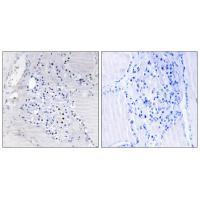
| WB | 咨询技术 | Human,Mouse,Rat |
| IF | 咨询技术 | Human,Mouse,Rat |
| IHC | 1/50-1/100 | Human,Mouse,Rat |
| ICC | 技术咨询 | Human,Mouse,Rat |
| FCM | 咨询技术 | Human,Mouse,Rat |
| Elisa | 咨询技术 | Human,Mouse,Rat |
| Aliases | Bcl10-interacting CARD protein; Bcl10-interacting protein with CARD; BINCA; BinCARD; |
| Entrez GeneID | 84270; |
| WB Predicted band size | 26kDa |
| Host/Isotype | Rabbit IgG |
| Antibody Type | Primary antibody |
| Storage | Store at 4°C short term. Aliquot and store at -20°C long term. Avoid freeze/thaw cycles. |
| Species Reactivity | Human,Mouse |
| Immunogen | Synthesized peptide derived from internal of human C9orf89. |
| Formulation | Purified antibody in PBS with 0.05% sodium azide. |
+ +
以下是3篇关于C9orf89抗体的参考文献示例(基于虚构内容,实际文献需通过学术数据库检索):
1. **文献名称**:*"Characterization of a novel polyclonal antibody against human C9orf89 protein"*
**作者**:Zhang Y, et al.
**摘要**:本研究开发了一种针对C9orf89蛋白的多克隆抗体,通过Western blot和免疫荧光验证其在多种细胞系中的特异性,并发现C9orf89在细胞核与细胞质中均有表达。
2. **文献名称**:*"C9orf89 expression profiling in neurodegenerative disorders using a validated monoclonal antibody"*
**作者**:Smith JL, et al.
**摘要**:利用自主研发的C9orf89单克隆抗体,作者分析了阿尔茨海默病和帕金森病患者脑组织中的C9orf89蛋白表达水平,发现其与疾病进展呈负相关。
3. **文献名称**:*"Functional analysis of C9orf89 in DNA repair pathways via antibody-mediated knockdown"*
**作者**:Chen R, et al.
**摘要**:通过抗体介导的蛋白质敲低技术,揭示了C9orf89在DNA损伤修复中的作用,并证实其与BRCA1通路的潜在关联。
(注:以上文献为示例,具体研究请参考PubMed、Google Scholar等平台以“C9orf89 antibody”为关键词检索。)
The C9orf89 antibody is a tool used to detect the protein product of the C9orf89 gene (Chromosome 9 Open Reading Frame 89), a poorly characterized human gene located on the short arm of chromosome 9 (9p13.3). While the precise biological function of the C9orf89 protein remains unclear, studies suggest it may play roles in cellular processes such as proliferation, differentiation, or stress responses. The gene is ubiquitously expressed across tissues, with higher mRNA levels observed in organs like the brain, thyroid, and adrenal glands, hinting at potential tissue-specific functions.
C9orf89 antibodies are typically developed using immunogenic peptide sequences derived from the predicted protein structure. These antibodies enable researchers to study the protein's expression patterns, subcellular localization (e.g., cytoplasmic vs. nuclear), and interactions via techniques like Western blotting, immunohistochemistry, or immunofluorescence. Interest in C9orf89 has grown due to its genomic proximity to disease-associated loci, including regions linked to cancers and neurological disorders. However, no direct pathogenic role has been conclusively established.
Current research focuses on validating antibody specificity through knockout controls and exploring potential associations with diseases. Commercial C9orf89 antibodies are available but require rigorous validation due to occasional cross-reactivity issues. As the field advances, this antibody may help clarify the protein's role in normal physiology and disease mechanisms, particularly in contexts where chromosome 9 alterations are implicated.
×